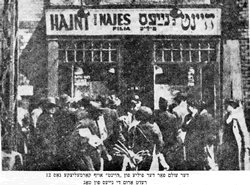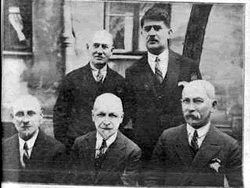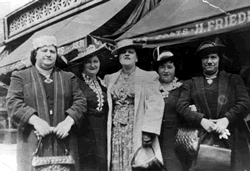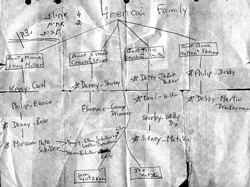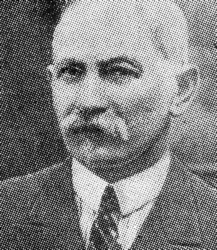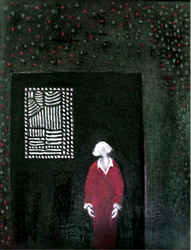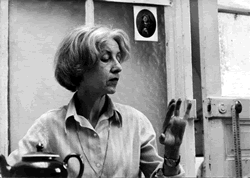Yazakan Family
Click
on Photos to Enlarge
#yzkn-1:
#yzkn-2
#yzkn-3
#yzkn-4
#yzkn-5:
Samuel Jackan
#yzkn-6
This is another photograph of my grand father S.J.Jackan.
Anna-Célia Kendall#yzkn-7 - #yzkn-9
TIYA
Tchyjo JACKAN-KENDALL-1919-2004
RÉTROSPECTIVE - Peintures, dessins
du 10 au 30 Octobre 2005
Maison Nationale des Artistes - Nogent sur Marne
Elle était la dernière des cinq filles de Rebecca et Samuel Jackan.
Son prénom était Tchyjo, Renaissance en hébreu. Mais pour faire plus simple, ou plus modeste, elle se faisait appeler Tiya. Née à Varsovie, elle préférait se réclamer de la Lituanie de ses parents et passait sous silence sa Pologne de sinistre mémoire.
Le sort tragique de sa mère était toute sa souffrance, le nom de son père était toute sa fierté.
Jackan avait été un homme exceptionnel, un Mentch. Ayant joué entre les deux guerres un rôle essentiel dans la reconquête des droits civiques des juifs d’Europe Centrale et la diffusion de leur culture, son Haint, quotidien fondé à Varsovie et distribué dans le monde entier, ainsi que son Parizer Haint, créé à Paris pour soutenir les immigrants chassés par la faim et les pogromes, sont aujourd’hui une mémoire précieuse aux historiens et aux enfants de la diaspora. Qu’importe que la bibliothèque de cet homme d’érudition fut entièrement brûlée par les nazis... car des collections de son journal sont conservées en France et aux Etats-Unis, mais surtout les écrivains tels que Singer, Aleichem, Peretz, qu’il a le premier soutenus et publiés, auront poursuivi leur œuvre. Tiya aimait le rappeler.
De son père elle avait hérité le raffinement, l’esprit vif, l’humour piquant, et un amour immodéré de la polémique. Elle était d’une intégrité irréprochable, d’une générosité sans borne et sans indulgence pour le moindre manquement à la parole donnée. Pas facile. Complexe, elle était encore espiègle, ce qui lui donnait un charme fou.
Après ses pérégrinations dans les meilleures pensions Suisses et Allemandes où elle a parfait sa culture Romantique, cette fleur de l’intelligentsia arrive à Paris en 1936 à l’âge de 17 ans. Elle fréquente l’Académie de la Grande Chaumière et entre aux Arts Déco. À la Ruche elle côtoie ses aînés, amis de Soutine, qui forment l’École de Paris, Mané-Katz, Kikoïne, Krémègne, Schreter… comme elle passés par la prodigue Vilnius. Elle sera gagnée par leur mélancolie alliée à la poésie des « choses simples , dans la filiation de Cézanne. Son voisin de palier, un jeune étudiant de Varsovie, qui deviendra son époux, essaye de vendre leurs tableaux…. quand il ne joue pas aux échecs dans un bouiboui de Montparnasse.
1940, Exode. Le couple se retrouve en Angleterre. Difficile de faire vivre son art entre l’effort de guerre et les abris. Mais il faut survivre. Avec les moyens du bord, elle confectionne de jolies ceintures, des foulards et devient graphic designer. Le temps passe, et il lui vient une fille. Le couple rentre en France, leur pays de cocagne. Pourtant ils se séparent. Mais il faut survivre. Elle peint à main levée de magnifiques tissus pour la haute couture, Lanvin, Esterel, Cardin, Dior… il faut fournir, elle peint, elle peint ces chefs d’œuvres jour et nuit… et tombe malade.
Au sanatorium, en 1970, elle a du temps, et se remet à dessiner. C’est une série de petits formats très mouvementés, un tantinet psychédéliques.
À partir des années 80, la modestie a repris ses droits, de tous petits dessins tendres, des petits collages de petits papiers.
Elle participe à de nombreuses expositions parisiennes, Rachi, Saint-Honoré, Ellora, Montorgueil, Couleurs… quelques dessins voyagent au Vietnam…
Tandis que sur le chevalet elle reprend inlassablement le même tableau, année après année, un auto-portait, dont à force elle a effacé les traits, sur un fond de plus en plus sombre…
À l’occasion de cette rétrospective une cinquantaine d’œuvres seront présentées, huiles sur toiles, bois et carton, aquarelles, dessins et collages, tissus. Une palette forte en noir et en couleur, beaucoup de gris-bleu, bleu-turquoise…
30-40 : études de nus, portraits et natures mortes,
50-60 : maquettes aux décors vifs et pétillants pour le textile,
70-80 : abstraction décorative où parfois le visage de sa fille apparaît.
Quant aux Autoportraits qui jalonnent sa vie, ils sont parmi les pièces les plus originales, les plus fortes et les plus touchantes.
Anna-Célia Kendall.
#yzkn-7
#yzkn-8
#yzkn-9
#yzkn-10
#yzkn-11
Yatzkan / Jackan Family
I talked with Sonia nee Kushner Lahav in Kibbutz Mizra in 2005. Sonia
told me that she is 81 years old. Her family was well of and
lived in Subacius, Lithuania ( near Vabalninkas). Her mother: Cheina
(nee Yatzkan)
Came from a well known family in the area. Cheina' uncle was Shmuel
Yatzkan the publisher of the Jewish newspaper: The Haynt
Her father; Wolf Kushner ,owned a large store and machines that were
used by the farmers in the area to break wool.
His connection with those Lithuanian farmers saved his life as well as
the life of three of his children and six other people.
Even before Germany attacked Russia, during the Soviet time in
Lithuania ( 1940)- Vulf Kushnir gave a farmer friend he knew by the
name of Malkevitz much of his belongings.
After the Nazis took control of the area the family was first in
Subacius, Lithuania in a
ghetto and later in the Ponovitzes Ghetto. The mother Cheina was killed
already in 1941 and her middle sister Mina was also killed. Her father was
able to escape with her brother, her youngest sister Aschia and her.
They walked for a long time during the nights until they arrived to
the farmer Malkevitz. He hid
them under the hay and after some time they were joined by other Jews
who escaped the ghetto and arrived to the farmers' home as instructed
by her father.
Life was very dangerous. They had to hide from neighbors and in great
fear that they would be discovered.
The Farmer talked to a priest and Sonia ( her her youngest sister
Aschia) were converted to be Christians. She remembers a long ceremony
with bread that ended by the
priest saying that now she will have to take a train ride and say that
she is a Lithuanian farm girl when she gets on the train. To encourage
her before taking the ride she was told that even if she would be
found and killed she will go to haven since she is a Christian.
She wore farmers clothes and held her mouth as if she has great pain
so if she needed to talk her Jewish accent would not be noticed.
She arrived to a monastery in the area of Rokishik were she became
assistant to the nuns.
The place was filled with orphaned little children that were left as
babies at the doorsteps of the monastery ( many must have been Jewish)
She had to take care of the little children and she loved her job. The
nuns were so happy with her that they said she must become a nun.
As the war ended she returned to her Jewish roots. Her brother who is
about 70 years old lives in London (He since passed away) . Her father
went to South Africa with the youngest daughter after the war. All the
people who hid with the farmer survived, despite the fact that a
neighbor informed the Germans. They escaped in
time and hid in another place.
A son of the farmer visited the families in Israel that his father rescued.
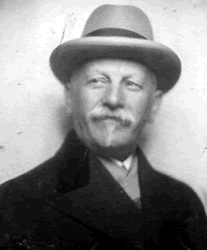
"In the years of transition from the 19th to the 20th century, I,
together with my brother and another young man, studied Hebrew with
Shmuel Yakov Yatzkan, who later became the founder and publisher of
the daily Jewish newspaper haynt [“Today”] in Warsaw. Yatzkan played
an important role in the development of the Zionist movement and in
Hebrew culture in Ponevezh. He and my father encouraged a strong
feeling of Zionism in the workers and young people. I believe that he
organized the first Zionist group of children under the name of
pirkhei tzion [“Flowers of Zion”].
Yatzkan was an autodidact and a “self-made man” [English in the
original]. He was born in Vabolnik, a small town not far from
Ponevezh. After his school years, he wandered around to various houses
of study and gegesn teg [eating and sleeping in different homes each
night]. He told us how, late at night, he and the other young men
would roast potatoes over the hot tin covers of the ovens. Except for
Yiddish and loshn koydesh [the “holy tongue,” i.e. Hebrew], he
basically knew no other languages. However, he had a feeling and a
sense for spiritual matters and easily oriented himself to the
problems of social and political life. I believe that his aesthetic
feelings were not highly developed. He had an unhappy relationship
with music. I remember how he plodded for weeks, attempting to learn
my father's nigun [melody] for haneros hal'lu [“We kindle these lights
for Chanukah”] so that he could sing with us when we lit the Chanukah
candles.
He was a talented teacher and developed sound educational principles.
When he was still a youth of 18, he wrote a booklet, Henokh Leyner
[Rav Gershon Henokh Leyner, the Radzyner Rebbe], about improving
Jewish education."
